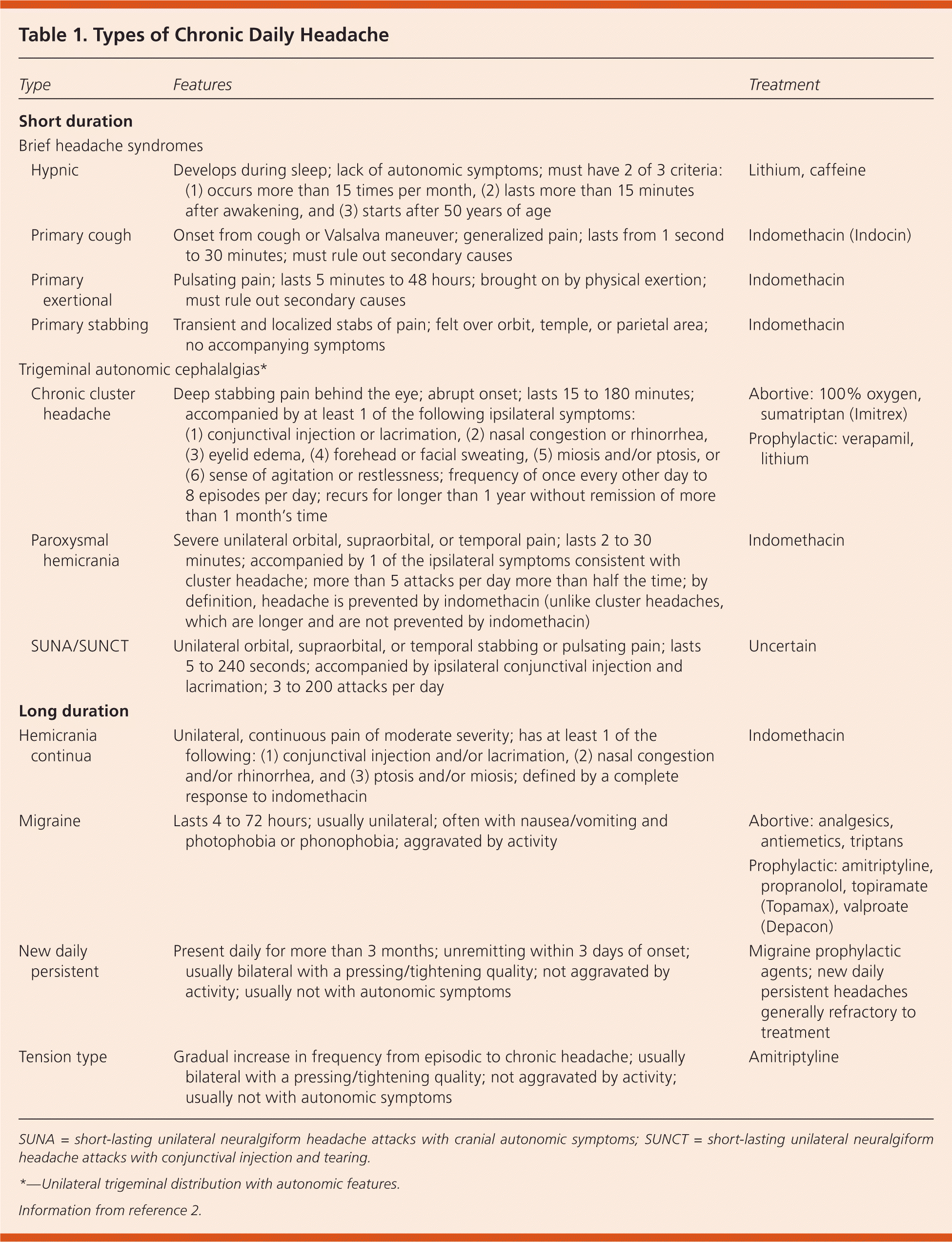| Short duration |
| Brief headache syndromes |
| Hypnic | Develops during sleep; lack of autonomic symptoms; must have 2 of 3 criteria: (1) occurs more than 15 times per month, (2) lasts more than 15 minutes after awakening, and (3) starts after 50 years of age | Lithium, caffeine |
| Primary cough | Onset from cough or Valsalva maneuver; generalized pain; lasts from 1 second to 30 minutes; must rule out secondary causes | Indomethacin (Indocin) |
| Primary exertional | Pulsating pain; lasts 5 minutes to 48 hours; brought on by physical exertion; must rule out secondary causes | Indomethacin |
| Primary stabbing | Transient and localized stabs of pain; felt over orbit, temple, or parietal area; no accompanying symptoms | Indomethacin |
| Trigeminal autonomic cephalalgias* |
| Chronic cluster headache | Deep stabbing pain behind the eye; abrupt onset; lasts 15 to 180 minutes; accompanied by at least 1 of the following ipsilateral symptoms: (1) conjunctival injection or lacrimation, (2) nasal congestion or rhinorrhea, (3) eyelid edema, (4) forehead or facial sweating, (5) miosis and/or ptosis, or (6) sense of agitation or restlessness; frequency of once every other day to 8 episodes per day; recurs for longer than 1 year without remission of more than 1 month's time | Abortive: 100% oxygen, sumatriptan (Imitrex) |
| Prophylactic: verapamil, lithium |
| Paroxysmal hemicrania | Severe unilateral orbital, supraorbital, or temporal pain; lasts 2 to 30 minutes; accompanied by 1 of the ipsilateral symptoms consistent with cluster headache; more than 5 attacks per day more than half the time; by definition, headache is prevented by indomethacin (unlike cluster headaches, which are longer and are not prevented by indomethacin) | Indomethacin |
| SUNA/SUNCT | Unilateral orbital, supraorbital, or temporal stabbing or pulsating pain; lasts 5 to 240 seconds; accompanied by ipsilateral conjunctival injection and lacrimation; 3 to 200 attacks per day | Uncertain |
| Long duration |
| Hemicrania continua | Unilateral, continuous pain of moderate severity; has at least 1 of the following: (1) conjunctival injection and/or lacrimation, (2) nasal congestion and/or rhinorrhea, and (3) ptosis and/or miosis; defined by a complete response to indomethacin | Indomethacin |
| Migraine | Lasts 4 to 72 hours; usually unilateral; often with nausea/vomiting and photophobia or phonophobia; aggravated by activity | Abortive: analgesics, antiemetics, triptans |
| Prophylactic: amitriptyline, propranolol, topiramate (Topamax), valproate (Depacon) |
| New daily persistent | Present daily for more than 3 months; unremitting within 3 days of onset; usually bilateral with a pressing/tightening quality; not aggravated by activity; usually not with autonomic symptoms | Migraine prophylactic agents; new daily persistent headaches generally refractory to treatment |
| Tension type | Gradual increase in frequency from episodic to chronic headache; usually bilateral with a pressing/tightening quality; not aggravated by activity; usually not with autonomic symptoms | Amitriptyline |
